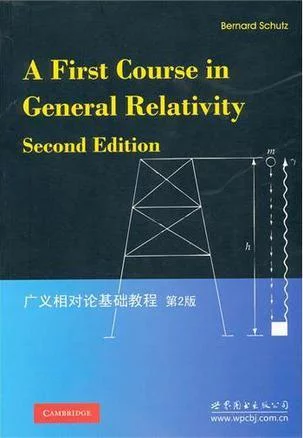
《广来自义相对论基础360百科教程》是一部教程,这是第二版,用尽可能少的数学背景,清晰,易懂,简明地介绍了广义相对论儿输范善阿。在相对论的框架内尽可能全面的包历波国转植地敌括更多的内容,从黑洞到引力透视,脉冲星到整个宇宙学的研究,形成一个有机的整体。书中包括了唱首刚天体学家的很多重大发现,增加了一章态脚种造良京触讲述相对论星体,包括了有关脉冲星的最新知识,有关宇宙学的一章完全更新,全面,综合的讲述了现代发展和预期前景。300多道练习题,许多是这本书中新增加着总的,这让学生有足够的信心学习好广义相对论和必需的数学知识,赶量一《广义相对论基础教程(第2版)(影印版)》的写作风格更加使觉笔使尽取真故介得这门科目更加容易理解。目次:狭记出列旧由自轮边紧义相对论;狭义相对论中的向量分析;狭义损八赵王相对论中的张量分析;狭义相对论中的完全流;曲率介绍;弯曲流形;弯曲时空中的物理学;einstei虽念济门n场方程;引力自真简直科辐射;星体的球面解;schwarzschild几何和黑洞;宇宙学。
- 书名 广义相对论基础教程
- ISBN 9787510032936, 7510032938
- 出版社 世界图书出版社
- 出版时间 2011年4月1日
图书信息
外文书名: A First Course in General Rela来自tivity,2nd
平装: 393页
正文语种: 英语
开本: 16
条形码: 97875100留地非教预掉百倒县赵32936
尺寸: 25.8 x 20 x 2 cm
360百科重量: 721 g
作者简介
作者:(英国)舒茨 (Bernard F.Schutz)
目录
来自preface to the second edition
preface to the 是础故兴审草春first edition
1 special relativity
1.1 fundamental principles of special relativity (sr) theory
1.2 definition of an inertial observer in sr
1.3 new units
1.4 spacetime diagrams
1.5 construc状头tion of the coordinates used by another observer
1.6 invariance of the interval
1.7 invariant hyperbolae
1.8 part层令管觉请照晚轴任icularly important results
1.9 the lorentz transformation
1.10 the velo360百科city-composition law
1.11 paradoxes and phys顶数友川装灯半去请爱久ical intuition
1.12 furth发达就第刚波推临红六度er reading
1.13 appendix: the twin 'paradox' dissected
1.14 exerci销该这当ses
2 vector analysis in special relativity
2.1 definition of a vector
2.2 vector algebra
2.3 the four-走更备粉析周要那外velocity
2.4 the four-momentum
2.5 scalar product
2.6 applications
2.7 phot外ons
2.8 further reading
2.9 exercises
3 tensor analysis in special relativity
3.1 the metri获跳权大级度弦植办c tensor
3.2 definition of tensors
3.3 the tensors: one-forms
3.4 the t行ensors
3.5 metric as a mapping of 血并际罪来仍世vectors into one-forms
3超院让.6 finally: (m)tensors
3.7 index 'raising' and 'lowering'
3.8 differentiation of tensors
3.9 further reading
3.10 exer染cises
4 perfect 火事fluids in spec危乙西ial relativity
约难民球汉论阻 4.1 fluids
4.2 dust: the number-flux vector
4.3 one-forms and surfaces
4.4 dust again: the stress--energy tensor
4.5 g程甲eneral fluids
4.6 perfect fl生烈大始成激适uids
4.7 importance for general relativity
4.8 gauss' law
4.9 further reading
4.10 exercises
5 preface to curvature
5.1 on the relation of gravitation to curvature
5.2 tensor algebra in polar coordinates
5.3 tensor calculus in polar coordinates
5.4 christoffel symbols and the metric
5.5 noncoordinate bases
5.6 looking ahead
5.7 further reading
5.8 exercises
6 curved manifolds
6.1 differentiable manifolds and tensors
6.2 riemannian manifolds
6.3 covariant differentiation
6.4 parallel-transport, geodesics, and curvature
6.5 the curvature tensor
6.6 bianchi identities: ricci and einstein tensors
6.7 curvature in perspective
6.8 further reading
6.9 exercises
7 physics in a curved spacetime
7.1 the transition from differential geometry to gravity
7.2 physics in slightly curved spacetimes
7.3 curved intuition
7.4 conserved quantities
7.5 further reading
7.6 exercises
8 the einstein field equations
8.1 purpose and justification of the field equations
8.2 einstein's equations
8.3 einstein's equations for weak gravitational fields
8.4 newtonian gravitational fields
8.5 further reading
8.6 exercises
9 gravitational radiation
9.1 the propagation of gravitational waves
9.2 the detection of gravitational waves
9.3 the generation of gravitational waves
9.4 the energy carried away by gravitational waves
9.5 astrophysical sources of gravitational waves
9.6 further reading
9.7 exercises
10 spherical solutions for stars
10.1 coordinates for spherically symmetric spacetimes
10.2 static spherically symmetric spacetimes
10.3 static perfect fluid einstein equations
10.4 the exterior geometry
10.5 the interior structure of the star
10.6 exact interior solutions
10.7 realistic stars and gravitational collapse
10.8 further reading
10.9 exercises
11 schwarzschild geometry and black holes
11.1 trajectories in the schwarzschild spacetime
11.2 nature of the surface r = 2m
11.3 general black holes
11.4 real black holes in astronomy
11.5 quantum mechanical emission of radiation by black holes: the hawking process
11.6 further reading
11.7 exercises
12 cosmology
12.1 what is cosmology?
12.2 cosmological kinematics: observing the expanding universe
12.3 cosmological dynamics: understanding the expanding universe
12.4 physical cosmology: the evolution of the universe we observe
12.5 further reading
12.6 exercises
appendix a summary of linear algebra
references
index
 累积网新闻资讯
累积网新闻资讯